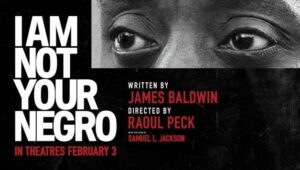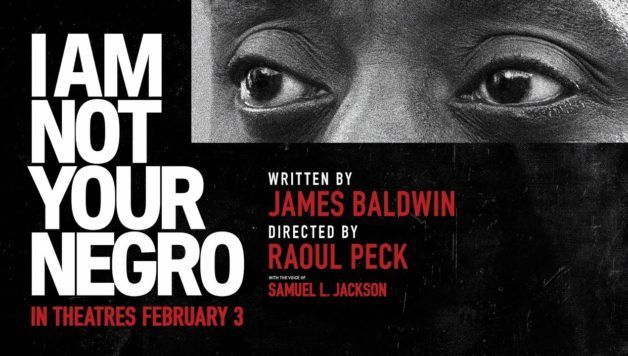Ryan Watson is a member of Socialist Alternative in the US.

“I cannot be a pessimist because I am alive. To be a pessimist means you have agreed that human life is an academic matter, so I am forced to be an optimist. I am forced to believe that we can survive whatever we must survive.” – James Baldwin
Like many millennials, James Baldwin did not grab my attention while I was in high school or college. When Baldwin did enter my consciousness it was evident from his first novel,
Go Tell It On The Mountain and
The Fire Next Time that he was an excellent writer. It was not until YouTube videos like James Baldwin’s debate with William F. Buckley on “whether the American dream is at the expense of the American Negro” started making the rounds on Facebook, and Twitter that Baldwin had a real impact on me. In this age of Black Lives Matter, his words 50 years later are still relevant.
The theatrical release and an Oscar-nominated documentary narrated by Samuel L. Jackson,
I Am Not Your Negro by Haitian-born director Raoul Peck is groundbreaking and inspiring. Peck’s film credits include
Lumumba, a biographical account of the U.S./Belgian coup d’etat and assassination of the first democratically elected prime minister of the Congo, Patrice Lumumba. This summer, Peck’s next film,
The Young Karl Marx, will be released in the United States.
I Am Not Your Negro is a product of an unfinished manuscript from 1979 titled
Remember This House that chronicles Baldwin’s friendship with iconic figures including Medgar Evers, Malcolm X, and Dr. Martin Luther King, Jr, and their political contribution to the black freedom movement. All three of these key figures were assassinated. Raoul Peck had full license and access to Baldwin’s estate. That access to the material is on full display throughout the documentary.
Harlem’s Son
Baldwin was born on August 2, 1924, and raised in Harlem, New York. Baldwin grew up in the harsh reality of poverty, racism, and paternal harshness mainly from his stepfather.
I Am Not Your Negro does an excellent job highlighting his relationship with one teacher. James Baldwin, a product of the New York City public school system, showed early signs of curiosity and wanting to understand, that sparked the interest of his teacher, a young white woman named Orilla Miller. Nicknamed “Bill” by the young Baldwin, Miller was to have a profound effect on Baldwin’s life. She directed his first play and encouraged his talents. The two discussed literature and went to museums together. Miller would even go to the extent to asking David Baldwin’s permission at the age to take James to the theater, previously prohibited. Later, Baldwin was to give her credit for his lack of racial bigotry. He explained that it was “certainly partly because of her, who arrived in my terrifying life so soon, that I never really managed to hate white people.”
I recognized a profound history in both him and “Bill.” As he described her, “Bill Miller was white,” but she was “not white for me in the way, for example, that Joan Crawford was white.” Neither, he goes on, was she white “in the way that the landlords and the storekeepers and the cops and most of my teachers were white. She too… was treated like a nigger, especially by the cops, and she had no love for landlords.” Baldwin learned from her that “white people did not act as they did because they were white.”
Although it appeared as though all oppressors were white, Baldwin realized not all whites were oppressors in American society. His profound speaking skills were cultivated in his three to four years in the church pulpit as a junior minister. Baldwin would leave the church because he viewed it as a form of escaping from the brutal relationship with his stepfather and questioned the tenets of Christianity which would be a major theme throughout his writing and social criticism of American capitalism and racism.
Baldwin as Witness
The documentary invokes the images and work of Medgar Evers, Malcolm X, and Dr. Martin Luther King, Jr. with Baldwin’s poetic words and fondness for his friends, with chilling effect. It also chronicles Baldwin’s return to the U.S. from France at the onset of the civil rights movement.
It is easy to assume that the three murdered martyrs, Medgar, Malcolm, and Martin, were involved in the struggle in a different way than James Baldwin. I believe, even in his eyes, referring to himself as a witness versus an actor, was meant to distinguish his contribution to theirs. Certainly, Baldwin, being a gay black man in the 1950s and ’60s, faced a deep struggle for acceptance and recognition in a very top-down, hyper-masculine, church-based black freedom movement.
The film’s narrator Samuel L. Jackson invokes the words of Baldwin with a haunting melancholy as the documentary begins in the deep South. The film begins with the valiant struggle against lynching and segregation in Mississippi. Medgar Evers, NAACP organizer, was a pivotal figure in the southern movement against Jim Crow. Evers became the first of Baldwin’s friends to die by the hands of racists in his driveway as his wife and children watched in horror.
The more well-known fighters for black freedom from different poles of thought and action, respectively Malcolm X, and Dr. King, are also highlighted. The film draws out the differences between Malcolm X and Dr. King and the evolution to a more common approach that was almost indistinguishable. Although Baldwin’s life was not ended violently like that of his three friends and subjects of the movie, he actively aimed over the years to draw out the perspectives and ideas of Martin and Malcolm for a new generation of activists after their assassinations. He talked about how highly he held Martin but said that people would no longer listen to him. He understood how Malcolm was attractive to young black people, corroborating their reality and showing them that they existed. He spoke highly of Malcolm because he did not ignore the poor, the people who were the janitors or convicts. Baldwin did not join the Nation of Islam (NOI), because he did not hate white people or agree with NOI leader Elijah Muhammad’s black American version of Islam. Baldwin didn’t join the Black Panthers or Gay Liberation movement because he didn’t want to be pigeonholed under organizational or ideological concepts. Baldwin was a shaper of ideas and an independent thinker.
The Struggle Continues
“Not only was I not born to be a slave: I was not born to hope to become the equal of the slave-master.” – James Baldwin.
The documentary does a fantastic job of linking the struggle of the 1960s to the present conditions black workers and youth face today under capitalism and racism. The documentary shines with Baldwin’s insightful thoughts on race, whiteness, and power. These ideas are examined in the movie, but also showed the value of these discussions today. Now in the age of the condensed news outlets controlled by five major conglomerates, the establishment have learned to never allow such a platform for another Malcolm or Martin or even a Baldwin. But the capacity of the corporate media to control the narrative has also diminished as we have seen the emergence of alternative independent news outlets.
Much like the YouTube video debate about “whether the American dream is at the expense of the American Negro,” this movie ask why does America need the negro? Baldwin touches on this point:
“It comes as a great shock to discover that the flag to which you have pledged allegiance, along with everyone else, has not pledged allegiance to you. It comes as a great shock, around the age of five or six or seven, to discover that Gary Cooper killing off the Indians when you were rooting for Gary Cooper – that the Indians were you. It comes as a great shock to discover the country which is your birthplace, and to which you owe your life and identity, has not in its whole system of reality, evolved any place for you.”
The youth of Ferguson rebelled in a town whose overwhelmingly black working class residents were taxed and criminalized through police state and Jim Crow-like policies. Baldwin in 1963 highlights this point, “I am sure they have nothing whatever against Negroes, but that is really not the question, you know.” Baldwin punctuates this point during another TV interview, “The question is really a kind of apathy and ignorance, which is the price we paid for segregation. It’s what segregation means; you do not know what’s happening on the other side of the wall because you do not want to know.” Ferguson, Baltimore, Tulsa, and the rise of Black Lives Matter showed that the oppressive system has not significantly changed the reality for black workers and youth 50 years later for the better.
Why I Am Not Your Negro Matters
This December 1, marks the 30th anniversary of James Baldwin’s death.
I Am Not Your Negro, is a fitting tribute and acknowledgment of Baldwin’s contribution to the struggle to end exploitation, structural racism and corporate domination over our lives. The film allows a new generation to delve into the richness of Baldwin’s words, insight, and voice as we build a multiracial, working class movement to confront Trump and Wall Street’s war against working, poor people, and people of color.
 “I cannot be a pessimist because I am alive. To be a pessimist means you have agreed that human life is an academic matter, so I am forced to be an optimist. I am forced to believe that we can survive whatever we must survive.” – James Baldwin
Like many millennials, James Baldwin did not grab my attention while I was in high school or college. When Baldwin did enter my consciousness it was evident from his first novel, Go Tell It On The Mountain and The Fire Next Time that he was an excellent writer. It was not until YouTube videos like James Baldwin’s debate with William F. Buckley on “whether the American dream is at the expense of the American Negro” started making the rounds on Facebook, and Twitter that Baldwin had a real impact on me. In this age of Black Lives Matter, his words 50 years later are still relevant.
The theatrical release and an Oscar-nominated documentary narrated by Samuel L. Jackson, I Am Not Your Negro by Haitian-born director Raoul Peck is groundbreaking and inspiring. Peck’s film credits include Lumumba, a biographical account of the U.S./Belgian coup d’etat and assassination of the first democratically elected prime minister of the Congo, Patrice Lumumba. This summer, Peck’s next film, The Young Karl Marx, will be released in the United States.
I Am Not Your Negro is a product of an unfinished manuscript from 1979 titled Remember This House that chronicles Baldwin’s friendship with iconic figures including Medgar Evers, Malcolm X, and Dr. Martin Luther King, Jr, and their political contribution to the black freedom movement. All three of these key figures were assassinated. Raoul Peck had full license and access to Baldwin’s estate. That access to the material is on full display throughout the documentary.
“I cannot be a pessimist because I am alive. To be a pessimist means you have agreed that human life is an academic matter, so I am forced to be an optimist. I am forced to believe that we can survive whatever we must survive.” – James Baldwin
Like many millennials, James Baldwin did not grab my attention while I was in high school or college. When Baldwin did enter my consciousness it was evident from his first novel, Go Tell It On The Mountain and The Fire Next Time that he was an excellent writer. It was not until YouTube videos like James Baldwin’s debate with William F. Buckley on “whether the American dream is at the expense of the American Negro” started making the rounds on Facebook, and Twitter that Baldwin had a real impact on me. In this age of Black Lives Matter, his words 50 years later are still relevant.
The theatrical release and an Oscar-nominated documentary narrated by Samuel L. Jackson, I Am Not Your Negro by Haitian-born director Raoul Peck is groundbreaking and inspiring. Peck’s film credits include Lumumba, a biographical account of the U.S./Belgian coup d’etat and assassination of the first democratically elected prime minister of the Congo, Patrice Lumumba. This summer, Peck’s next film, The Young Karl Marx, will be released in the United States.
I Am Not Your Negro is a product of an unfinished manuscript from 1979 titled Remember This House that chronicles Baldwin’s friendship with iconic figures including Medgar Evers, Malcolm X, and Dr. Martin Luther King, Jr, and their political contribution to the black freedom movement. All three of these key figures were assassinated. Raoul Peck had full license and access to Baldwin’s estate. That access to the material is on full display throughout the documentary.




